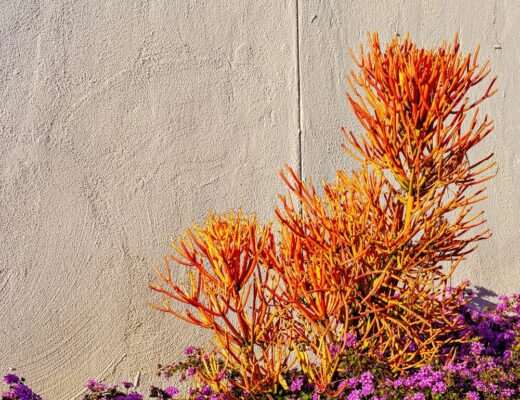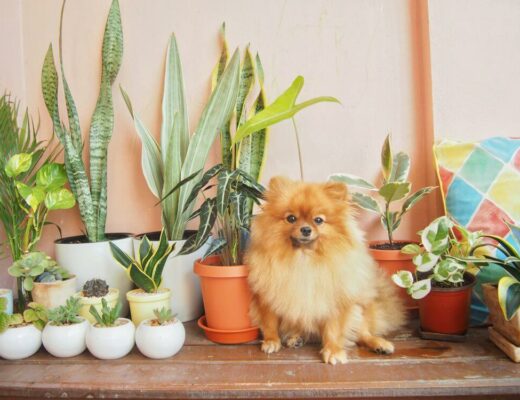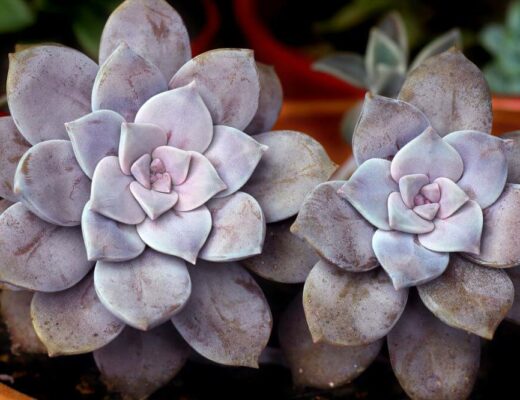Succulents, cacti included, have a variety of different needs, including varying preferences in light. While most do prefer bright environments, there are succulents that don’t need much light at all! These are perfect for that empty corner of the room or that one apartment window that never seems to get enough direct sun.
This list of low light succulents will help you fill out your collection, even in the shadier areas in your home.
But first, what is considered low light?
A low light environment means that no direct light source will touch your plant. Examples of low light places in your home include an area in a part of a room that doesn’t receive direct light, or on a window sill that sunlight never directly touches. In the northern hemisphere, low light windows are north and north-east facing; it is the opposite for the southern hemisphere.
A great way to test the intensity of light is to look at the shadow that is casted. If the shadow is sharp and crisp, the intensity of the light is bright and direct. The more fuzzy the shadow appears, the lower the light intensity.
Remember, low light does not mean no light. All plants need some source of light for photosynthesis and growth to occur.
If you want plants in a room that doesn’t have windows, you will need a source of artificial light from a plant grow lamp.
Many lists of low light succulents on other sites include succulents that can technically survive with low light, however the majority of them will not thrive. That’s not what I’m going to give you.
This list will highlight an array of unique succulents and other plants that can reach their full potential even in low light conditions.
1. Haworthia fasciata ‘Zebra Plant’
Native to South Africa, Haworthia fasciata ‘Zebra Plant’ is a great indoor plant for new succulent enthusiasts. Similar to the shape of aloe, with dark green triangular tapered leaves covered in white bumpy stripes, this is one of the best indoor succulents for low light conditions.

In order to mimic its natural environment, ensure your ‘Zebra Plant’ is potted in well-draining soil. Allow soil to dry completely between waterings.
Opposite of most succulents, ‘Zebra Plants’ grow at a slower rate during the summer so you’ll need to water less in summer months than in winter months.
If you’re interested in propagating, keep and eye out for new groupings of baby plants that grow out from the base. These can easily be separated and repotted.
- Mature Size: 3” tall, 6” wide
- Hardiness: Zone 10
2. Sansevieria trifasciata ‘Snake Plant’
This is a super beginner-friendly and low light succulent! Snake Plants come in a handful of varieties with different length leaves that display different colors, patterns and shapes. These succulents love low light conditions, but don’t do well with a lot of humidity. This means you should avoid placing them in bathrooms.

To water, still saturate the soil, but extend the time between waterings even longer than with other succulents.
Snake Plants can be propagated by its leaves and by division of its root. Healthy leaves that are removed can be planted in soil after being allowed to callous over for 3-5 days.
Leaves can also be propagated in water; place the leaf in a container tall enough to support the leaf’s height and add 2-4 inches of water. Ensure the water is changed frequently
The root of a Snake Plant is called a rhizome that can be divided and replanted.
There are numerous varieties of Snake Plants that have different characteristics such as Sansevieria trifasciata ‘Black Gold’, ‘Twisted Sister’, ‘Golden Hahnii’, and ‘Laurentii.’
- Mature Size: 4’ tall, 2’ wide
- Hardiness: Zones 10-12
3. Sansevieria cylindrica ‘African Spear’
Sansevieria cylindrica is a species within the same genus as Sansevieria trifasciata with very similar care needs. Instead of broad, flat leaves, a Sansevieria cylindrica will have, as its name alludes to, tapered cylindrical leaves.

The spear-shaped leaves are dark green striped with light colors of green. The leaves grow in a rosette pattern like Echeveria, and can grow to be 1 inch in diameter. A full mature plant can grow up to 2 feet tall.
Propagate to make new plants by separating the new offsets that grow out from the base of the main plant.
- Mature Size: 6’ tall, 2’ wide
- Hardiness: Zones 10-11
4. Portulacaria afra ‘Green’
Also called the Elephant Bush, this low light succulent mimics the growth of a jade plant with four leaf clover shaped leaves. Bright green leaves grow from deep reddish-brown stems, creating a beautiful extra pop of colors perfect for any room.

Depending on how it is planted, either outdoors in a shaded bed or inside in a small pot, a Protulacaria will grow as a trailing ground-cover or as a small vertical bonsai plant, respectively.
When planted indoors, place this succulent near a window but well out of the way of direct sunlight.
Water thoroughly and allow soil to dry completely in between waterings.
- Mature Size: Over 12” tall
- Hardiness: Zone 10
5. Gasteria ‘Little Warty’
Gasteria is a genus of succulents that love low light conditions, they do so well that you could even call them the King of Low Indoor Light! ‘Little Warty’ is true to its name; the leaves are covered in an array of cream colored textured spots. Mainly green, the leaves do feature creamy white stripes and reddish-copper tones.

New wide flat leaves grow on top of older leaves, creating a fan shape that reaches up to 5 inches.
Unlike other succulents that need bright light to maintain different colors, ‘Little Warty’ will keep its bronze hues even in low light.
Gasteria ‘Little Warty’ will do best when deep in well draining, gritty soil and watered infrequently. If you are lucky enough to see your ‘Little Warty’ flower, you will see from where Gasteria got its name; the flowers are stomach-shaped.
- Mature Size: 5” tall
- Hardiness: Zone 10
6. Haworthia cooperi var. obtusa
This cute little low-light loving succulent grows in clumped rosettes made of rounded, translucent leaves. The tops of the leaves are like clear frosted glass that grow down into green bases.

These succulents have adapted very well to low light and low water conditions. Be very careful not to overwater or root rot will set in quickly. Your plant will begin to turn red when exposed to too much sunlight, so to keep that deep glassy green, keep out of direct light.
A shady, north facing window is the perfect place for this plant!
Plants quickly grow new offsets at the base of the parent plant. That makes it a great succulent if you’re interested in propagating regularly.
- Mature Size: 5” tall, 4” wide
- Hardiness: Zone 10
7. Haworthia cymbiformis
With the same fleshy translucent leaves characteristic of most Haworthia, Haworthia cymbiformis has clumped pointy, striped leaves that form small 4 inch clusters.

Plant in well draining soil and avoid sitting water at the base of the roots.
- Mature Size: 5” tall, 4” wide
- Hardiness: Zone 10
8. Beaucarnea recurvata ‘Ponytail Palm’
Despite having “palm” in its name, the Ponytail Palm is actually a low light succulent that is closely related to the Agave family. This succulent has a bulbous woody trunk that is topped with thin curved, green leaves growing in a ponytail-like fashion.

When planted inside, leaves can grow up to 3 feet long. An indoor Ponytail Palm can reach a full height of 4 feet when mature. Outdoors in an environment similar to its native Mexico, these succulents usually reach up to 10 feet tall, with records showing some plants growing up to 30 feet in height.
Place this plant indoors near a window that receives low-light or on a shelf across from a window. Water the well draining soil infrequently and allow the soil to dry between waterings. Signs of overwatering are yellowing leaves and a squishy stem. Brown-tipped leaves are a sign that you may need to up the frequency of waterings just a bit and move a little farther away from bright light.
Ponytail Palms don’t do well in high humidity, so they should not be placed in bathrooms or other humid areas.
- Mature Size: 6-8’ tall indoors
- Hardiness: Zones 8-11
9. Epiphyllum anguliger ‘Fishbone Cactus’
Did you know that cacti are succulents too?! Cacti in the Epiphyllum genus originate from the tropical, humid environments of the rainforest. They don’t have the spiky thorns we associate with desert cacti. Looking for a plant that will love the humidity of your bathroom after a warm shower? An Epiphyllum is the way to go!

The Fishbone Cactus (like all other Epiphyllum) don’t have leaves, only stems. Their stems are smooth and green and grow in a zig-zag pattern. The highly branched stems grow long and trailing, perfect for a hanging planter.
Exquisite white and pale yellow flowers bloom at night that give off alluring sweet scents and produce small green fruit.
Fishbone Cacti need more water than other low light succulents and cacti. Allow the soil to only dry out at the top few centimeters before watering again. To increase the humidity, mist your plant daily and place on top of a wet pebble tray.
The Fishbone Cactus should still be planted in coarse, well draining soil.
Because of its affinity for humid environments, Epiphyllum are susceptible to different bacterial and fungal infections. Keeping your plant in a well ventilated area and planted in a pot with a drainage hole can help prevent an overaccumulation of water.
- Mature Size: 8”-12” long
- Hardiness: Zone 10-11
10. Schlumbergera bridgesii ‘Christmas Cactus’
Another ideal low light succulent is the Christmas Cactus. These cacti are named for the time in which they bloom, usually between Thanksgiving and Christmas!

Flat leafed and trailing, the Christmas Cactus produces red or fuchsia colored flowers that can last for weeks on end if cared for properly. Schlumbergera bridgesii is an epiphyte so it does not have the characteristic spines like other cacti.
Keep your Christmas Cactus in a window, away from direct sun. Make sure the pot is not directly under or over house vents to avoid drafts. To maintain humidity, place the pot on a wet pebble tray.
Propagation is easily done using cuttings. Gently pinch off a segment of this low light cactus with 3-4 joints. Allow the end to harden and callous over a few days. Repot in new soil and you will start to see growth within a couple weeks.
- Mature Size: 10” tall, 2’ wide
- Hardiness: Zone 9-11
11. Hatiora salicornioides ‘Dancing Bones’
Hatiora salicornioides is a tall branching, thin stemmed cactus that can grow up to 2 feet tall. Stems resemble the shape of a baseball bat or a glass pop bottle. Yellow flowers top these stems during spring.

Pot in well-draining soil and place in a window that receives indirect light. In the northern hemisphere, a north or north east facing window is suitable. Water consistently to keep the soil moist, however never allow the soil to stay soaking wet.
This low light cactus can be propagated with cuttings. Cuttings should be placed in new soil immediately for best results.
- Mature Size: 3’ tall, 3’ wide
- Hardiness: Zone 10-12
Extra Tips and Tricks
Again, low light does not mean no light. No plant can survive in total darkness. The low light succulents I listed above are great in these conditions, but they may need a bit more light exposure if you notice the following signs:
Sign 1: Succulents will start to display signs if they are getting too little light. If you notice that your low light succulent is getting leggy and stretched out, this may mean you need to up the amount of light it is receiving. Larger gaps between each leaf will occur.
Sign 2: Your succulent’s lower leaves may also begin to point downward instead of extending up towards the sun.
If you notice these two things happening, you can move your succulent a bit closer to a natural light source. For example, if your low light succulent that you’ve placed on a shelf needs a bit more light, consider moving it to a shaded northern facing window sill.
You can also supplement extra hours of light by adding a stylish grow light. Turn it on for a couple of hours in the evening. This is extremely helpful during the winter months when our days grow substantially shorter.
Final Thoughts
Low light succulents are a perfect addition to a succulent collection, especially if you live in an apartment or in a naturally shady area.
They are unique in their ability to live in low light conditions and have evolved to have specific characteristics that allow them to thrive.




